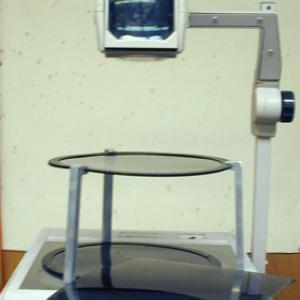College of Liberal Arts & Sciences
6H30.10 - Polarization - Three Polaroids
Place two circular Polaroids on the overhead in the regular manner and set for extinction. Insert the third sheet between these two and show that now some light will pass.
See the "Bauman" and "Rossing and Chiaverina" references below for the Quantum Mechanical explanation of why the insertion of a third polarizer BETWEEN two crossed Polarizers allows light to pass.
The Quantum Kaleidoscope units are hand held versions of the 3 Polaroid demo. These also come with an activity sheet of activities.
- Peigi Li, Xun Lei, Haonan Cui, Lu Zhao, "Malus's Law and a Dynamic Three-Polarizer System", TPT, Vol. 62, #4, April 2024, p. 302.
- Seymour Charas, "Interference and Polarized Light", TPT, Vol. 26, #9, Dec. 1988, p. 570.
- Robert P. Bauman and Dennis R. Moore, "Classical Demonstration of Polarization", TPT, Vol. 18, #3, Mar. 1980, p. 214.
- "Transmission of Light Through Polarizers in Series", TPT, Vol. 4, #4, Apr. 1966, p. 192.
- P. C. B. Fernando and S. Samarasinghe, "A Technique for Experimentally Observing the Polarization Ellipse", AJP, Vol. 64, #5, May 1996, p. 565.
- Bill Franklin, "How Can Light Get Through Crossed Polarizers", Teaching About Color & Color Vision, 1996, p. 3D-3.
- T. D. Rossing and C. J. Chiaverina, "7.1, Polarization By Selective Absorption", Light Science, Physics and Visual Arts, p. 152 - 155.
- Martin Gardner, "A QM Paradox", Science Tricks, p. 68.
Disclaimer: These demonstrations are provided only for illustrative use by persons affiliated with The University of Iowa and only under the direction of a trained instructor or physicist. The University of Iowa is not responsible for demonstrations performed by those using their own equipment or who choose to use this reference material for their own purpose. The demonstrations included here are within the public domain and can be found in materials contained in libraries, bookstores, and through electronic sources. Performing all or any portion of any of these demonstrations, with or without revisions not depicted here entails inherent risks. These risks include, without limitation, bodily injury (and possibly death), including risks to health that may be temporary or permanent and that may exacerbate a pre-existing medical condition; and property loss or damage. Anyone performing any part of these demonstrations, even with revisions, knowingly and voluntarily assumes all risks associated with them.
